Bouncers, the original sentient species on Ruusan, were peculiar beings. Resembling green-furred globes, they earned their moniker from their unique way of moving: harnessing the wind, they propelled themselves off of objects to achieve remarkable altitudes. Green fur covered their bodies, and numerous tentacles sprouted from them, with half terminating in delta-shaped appendages suited for digging and writing on the ground.
The homeworld of the Bouncers became the stage for a significant battle during the New Sith Wars, pitting the Army of Light against the Brotherhood of Darkness. Displaying compassion, the Bouncers offered aid and solace to the dying on both sides, utilizing their subtle telepathic abilities. As the conflict reached its climax with Lord Kaan's devastating deployment of the thought bomb, which imprisoned the spirits of countless Jedi and Sith, the Bouncers upheld a prophecy: "a Knight shall arrive, a battle shall occur, and the captives shall be freed." They played a crucial role in the prophecy's fulfillment by guiding the Jedi Kyle Katarn to the planet's Valley of the Jedi more than a millennium afterward. Additionally, a Bouncer was instrumental in ensuring the survival of Rain, who would later become the Sith Lord Darth Zannah.
The sentient Bouncers were an indigenous species of Ruusan. Shaped like medicine balls, they gave off an impression of fragility. Their internal structure was akin to balloons, rendering them remarkably light. Their skin felt leathery, warm, and dry. Under infra-red vision, they appeared merely as green blobs. The Ruusan breezes caused their covering of green hair to flutter. Their faces were dominated by a pair of enormous, luminous eyes with large pupils, optimized for gathering light due to their nocturnal habits. Bouncers lacked a visible nose or mouth.
Numerous tentacles extended from their spherical bodies, with half ending in delta-shaped appendages that functioned effectively as digging tools. The Bouncers employed these tentacles as "brakes" against the ground to reduce speed while floating. They could also stand on them when clustered together, or use them to "walk" along the ground. These dexterous tentacles were used to manipulate objects, such as styluses. When bouncing, these tentacles often trailed behind, creating a ghostly effect.
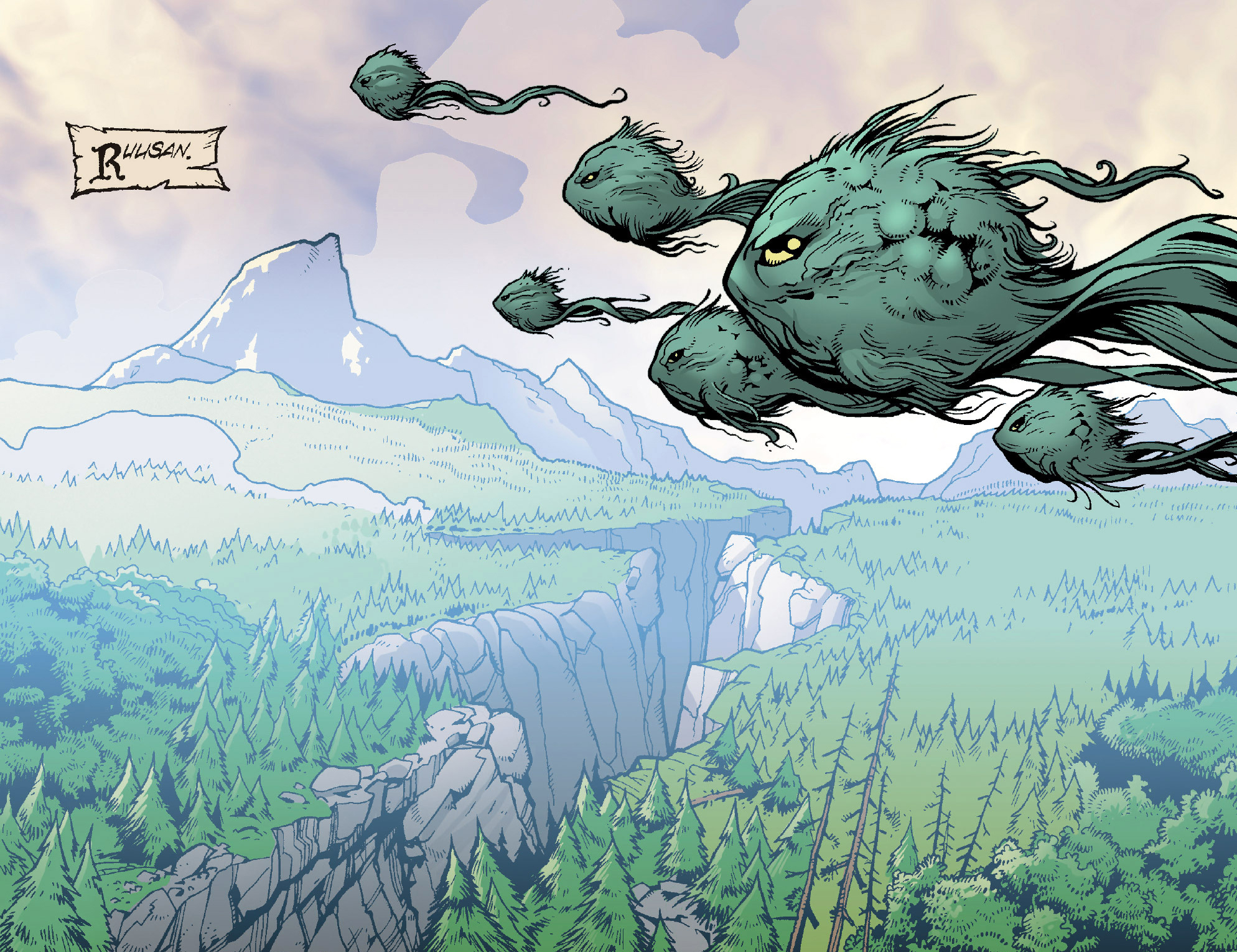
The Bouncers' primary mode of transportation depended on the wind. Their balloon-like bodies and minimal weight allowed them to be easily carried by the wind. They could manage their speed and direction using specialized skin flaps that acted as wind vanes. By adjusting these flaps, they were able to steer themselves. They would aim for obstacles like rocks or boulders, and in this way, they "bounced," which led to their name. This method enabled them to reach heights of up to fifty or sixty meters. Larger Bouncers could even carry additional weight without affecting their momentum.
Bouncers could also slow down by manipulating their tentacles and creating friction against the sand. They then used their tentacles to secure themselves to the ground against the wind. In this manner, tribes of Bouncers traveled across the Ruusan plains and wastelands, tacking and wheeling together.
Bouncers also enjoyed climbing large rock spurs with their tentacles, from which they would launch themselves into the air, floating until gravity pulled them back to the ground. Some considered their movement to be dance-like, and for Morgan Katarn, it symbolized freedom.
Bouncers were able to manipulate the Force, able to feel it, and their presence generated ripples in the Force. They communicated by using the Force to send out thoughts, although they seemed capable of understanding spoken words. The Force also frequently provided them with dreams and glimpses of the future. These visions were often accurate, predicting both immediate and distant events. However, when conveying these oracles, they expressed them in vague riddles and generalities. These dreams came at a cost; weak Bouncers could be killed by dark visions. They could emit soothing auras to dull the mental anguish of others, or, when angered, inflict mental trauma on those nearby.
The Bouncers' society remained largely unchanged over millennia. As of 4 ABY, they maintained a pre-industrial society, with a population between 18,000 and 20,000 individuals. They were organized into tribes of approximately fifty to sixty members, led by an elder Bouncer.
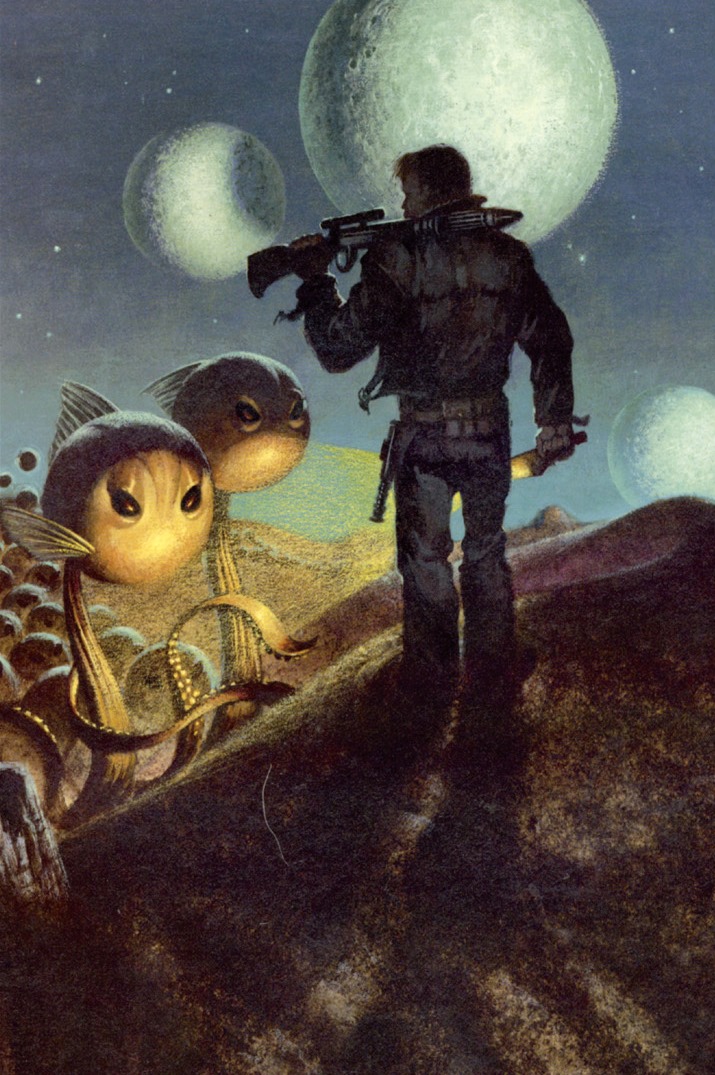
The Bouncers inhabited the mountainous regions of their planet, avoiding the deserts that were commonly roamed by the Ruusanians. While Ruusan was once a temperate world with vast forests, the explosion of Lord Kaan's thought bomb transformed much of the planet into arid wastelands. Consequently, the Bouncers adapted their behavior. Water became increasingly scarce. To address this, each morning, the Bouncers dug shallow depressions and placed inverted cones within them. These depressions were then covered with a thin, semitransparent tissue. These structures acted as water stills, condensing moisture from the air and collecting it in the cones. This provided the Bouncers with a water supply when they emerged at night. They also developed herbal medicines and natural remedies for their ailments.
Bouncers communicated with each other through a series of whistles and warbles. They also possessed mild telepathic abilities, allowing them to sense the emotions of those around them, both Bouncers and aliens alike. Telepathy enabled them to communicate directly with certain individuals, projecting thoughts into their minds, as demonstrated in the relationship between Laa and Rain. However, they could not read specific thoughts and required the other party to speak aloud.
Their most frequent method of communication with aliens was through writing. They used Basic, which they scribbled into the sand of Ruusan. By 4 ABY, their syntax was considered peculiar, filled with archaic language, yet still comprehensible.
Due to their reliance on wind for movement, Bouncers were patient beings, sometimes displaying a certain fatalism in their approach to the world. This was exemplified by their defensive technique when attacked: the tribe would cluster together, turning inwards. When an Imperial patrol led by Forley attacked them, their slaughter was only averted by the intervention of Jan Ors and the colonists of Fort Nowhere. On other occasions, the Bouncers defended themselves as best they could. Later in the same incident, a Bouncer grabbed Forley's head and enveloped it with its tentacles. In a panic, Leeno, one of Forley's stormtroopers, shot the creature, killing both it and his commanding officer. However, this brave action was another manifestation of their fatalism.
Bouncers also held a deep respect for life, feeling compelled to heal and comfort others. This extended to physically saving lives, such as that of the child Rain. Despite premonitions that her life would be difficult, Laa insisted that "life is life" and saved Rain.
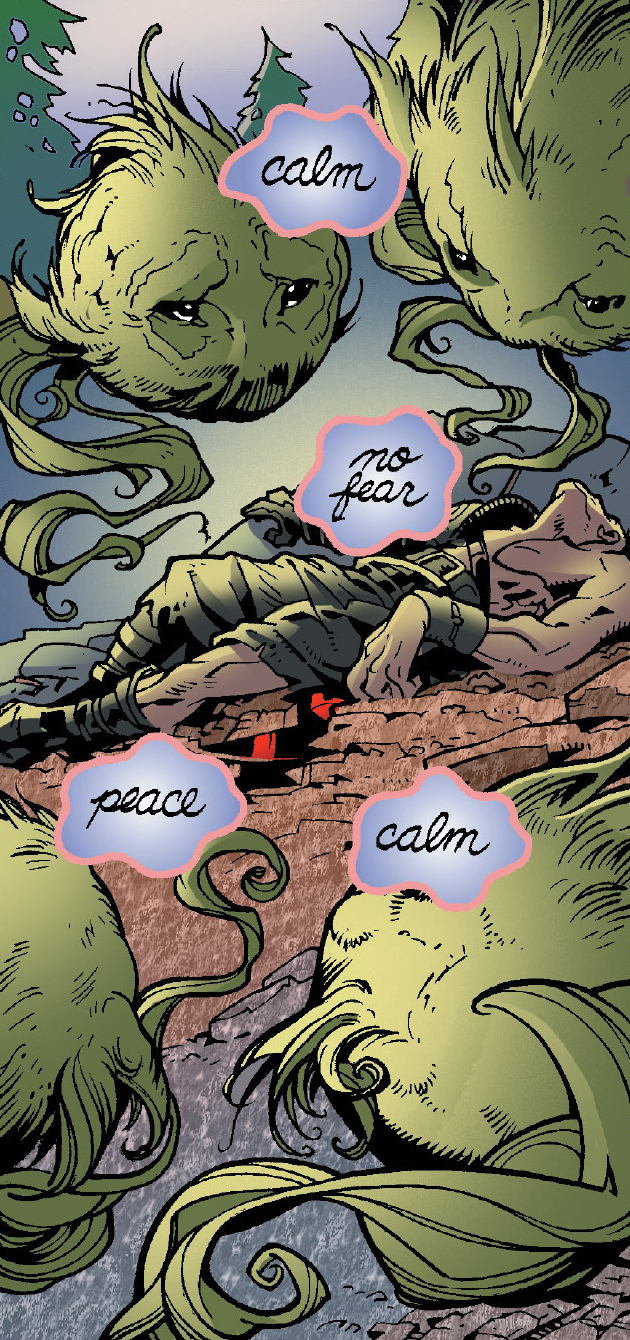
The Bouncers evolved on Ruusan as its only sentient species. The Galactic Republic eventually discovered the planet, and as part of the expansion of the Teraab sector, it was settled by the Mining Guild. Deposits of iron, copper, cesium, iridium, nickel, and uranium were found on the planet, but they proved less significant than those on neighboring planets such as Drogheda, Istic II, Pesmenben IV, and Tyne's Horky. As a result, settlement was sparse, and the Bouncers coexisted peacefully with the miners, farmers, and trappers.
The planet gained unexpected significance during the New Sith Wars when it became a symbolic battleground. A Sith victory would signify their inevitable triumph, while a Republic victory would demonstrate the Jedi's ability to defeat their enemies. This led to seven major battles and countless skirmishes on Ruusan. The Bouncers remained neutral, instead offering assistance to both sides. Using their mild telepathy, they visited the aftermath of battles and projected images of comfort to the wounded. They became a welcome sight to both sides, aiding in healing.
However, this changed when the Sith began using powerful dark side rituals to defeat the Jedi. Led by Darth Bane, the Sith unleashed an unnatural firestorm that destroyed vast forests, killing many Jedi and forcing others into the open. The impact on the Bouncers was devastating. The fires killed most, and the survivors were driven mad by the cataclysm. Their ability to comfort was horribly twisted, and they began projecting terror, panic, and nightmares to the sick and wounded. The Jedi were forced to kill the tormented beings to maintain their own morale.
Only one Bouncer, Laa, escaped the madness. Earlier, she had saved the life of a Human girl named Rain. Rain, a recruit for the Army of Light, was separated from her unit when her starship was damaged by Sith Buzzards. Laa caught Rain as she fell from the ship. Rain was strong in the Force and instinctively protected Laa from the Sith firestorm. Laa's decision had significant consequences for the future of the Sith. In prophetic dreams, Laa foresaw Rain becoming a powerful dark Jedi. Laa carried Rain for days until they encountered Jedi forces. Mistaking Laa for a threat, the Jedi Petja shot and killed her. Instinctively, Rain used the Force to kill the two Jedi. Laa's death triggered Rain's turn to the dark side. The grieving child was found by Darth Bane, who took her as his apprentice. She eventually became Darth Zannah, a Dark Lord of the Sith.
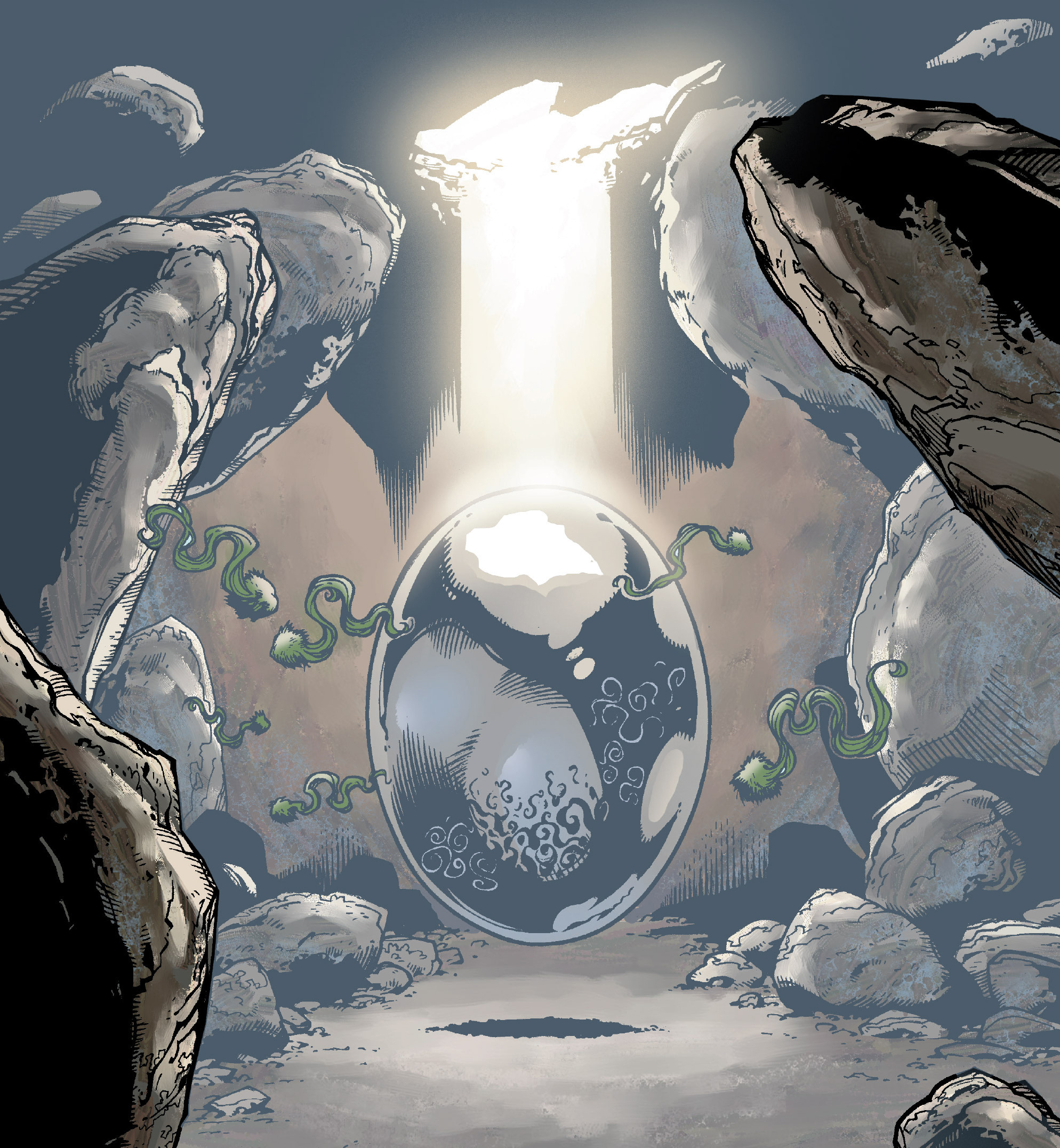
The conflict between the Jedi and Sith ended when Lord Kaan used the thought bomb, a Sith ritual that created a receptacle for the dark side. When detonated, it absorbed the spirits of all nearby Jedi and Sith. This destroyed the Sith forces and many Jedi, ending the war on Ruusan.
The conflict had a devastating effect on the Bouncers. Many were killed by the Sith fires, the Jedi, and the thought bomb, pushing the species to near extinction. The survivors faced a changed world, as the thought bomb had transformed much of the planet into a wasteland. Two surviving Bouncers found Rain's cousin Darovit after the battles, speaking directly to his mind and strengthening his will to live after he lost a hand. They led him to food and medical supplies, helping him treat his wound and prevent infection. Over the next decade, the Bouncers became fascinated with Darovit. They taught him their herbal lore, and two or three Bouncers always circled his hut and accompanied him on his travels. One such Bouncer was Yuun, who was with Darovit when he discovered the Republic had returned to Ruusan to build a monument to their fallen. Darovit tried to sabotage the project but failed. He eventually fought his cousin in a duel when Rain returned as a Sith Lord.
The Republic monument became known as the Valley of the Jedi. Statues of the fallen Jedi were erected, along with numerous tombs. While the memorial was popular for a time, the Republic soon forgot it. However, the Bouncers recorded these events in their "Poem of Ages," which included prophecies, including one about the Valley of the Jedi. This prophecy foretold of a Jedi Knight who would come to the planet, fight a battle, and free the prisoners trapped within the thought bomb. They preserved the prophecy for nearly a thousand years, and it was also recorded offworld.
The Bouncers slowly recovered their numbers on Ruusan, long after the Republic had forgotten its location. Shifting nebulae in the Teraab sector erased the former hyperspace routes, isolating the planet, which soon became a myth. Around 11 BBY, the smuggler Jerg rediscovered the planet by accident, when he made a random hyperspace jump while being pursued by an Imperial Star Destroyer. He and his team recognized the value of the planet's obscurity and established Fort Nowhere, a small fort to store contraband.
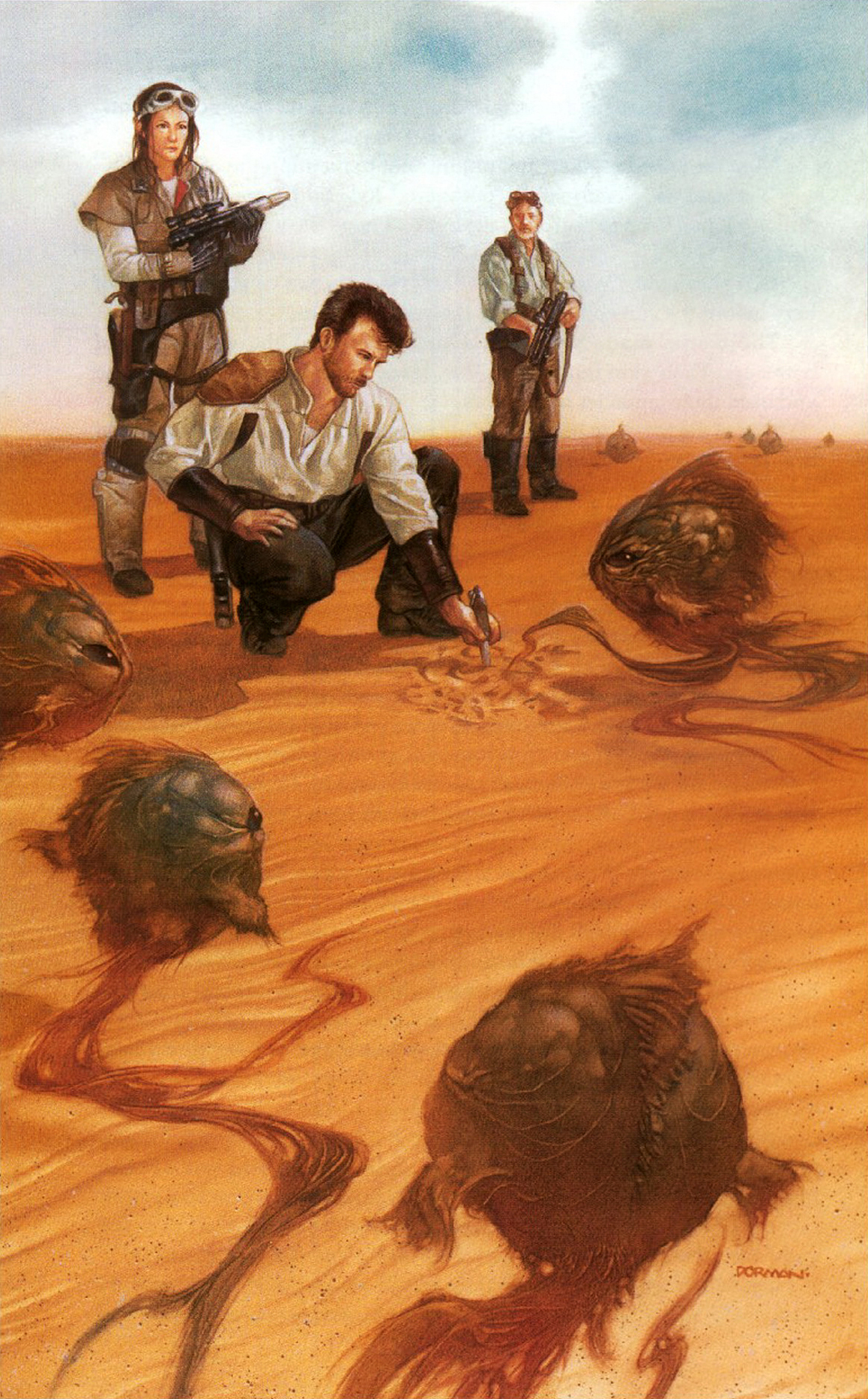
The Bouncers kept a low profile, continuing their nomadic existence without significant contact with the smugglers. Ruusan received another influx of foreigners when Morgan Katarn led 347 refugees from Sulon to the planet. The inquisitive Katarn explored the countryside. The Bouncers sensed his approach and believed him to be the one to fulfill the prophecy regarding the Valley of the Jedi. They detected his Force-sensitivity and regarded him as a Knight. Furthermore, Morgan had inadvertently fulfilled part of their prophecy by camping above the city of Olmondo, which was buried under the sand. The Bouncers directed Katarn to the Valley, hoping he would fulfill the prophecy. However, Katarn realized he lacked the power to free the trapped spirits and left. Despite this failure, the Bouncers remembered their encounter with Morgan, calling him "the Knight who never was."
The Bouncers had little contact with the refugees after this encounter, remaining elusive. Many colonists feared and loathed them, but some, such as Grif Grawley, found them beautiful and fascinating, despite only brief encounters. While looking for Bouncers, Grawley detected an Imperial probe droid launched by the dark Jedi, Jerec. Jerec sought the Valley of the Jedi and had finally discovered Ruusan. Grawley destroyed the probe droid and warned the settlers of the Imperial discovery. He then hid in nearby caves, avoiding the subsequent Imperial razing of the fort.
Morgan's son, Kyle Katarn, visited the planet soon after, to prevent Jerec from taking control of the Valley. He met Grawley, who suggested consulting the Bouncers on the location of the Valley. While Grawley, Kyle, and their group waited for the Bouncers, an Imperial patrol attacked the tribe as it crossed the desert. The Imperial forces had begun hunting the defenseless native species for amusement, taking their bodies as trophies. The Bouncers responded by clustering together, which would have resulted in their deaths if the rebel group had not intervened. In the confusion, the Bouncers acted more assertively. One wrapped its tentacles around the head of the stormtrooper Forley, blinding him. His companion panicked and shot the Bouncer, killing his commanding officer. Other Bouncers knocked the trooper to the ground, pinning him there until the rebels arrived.
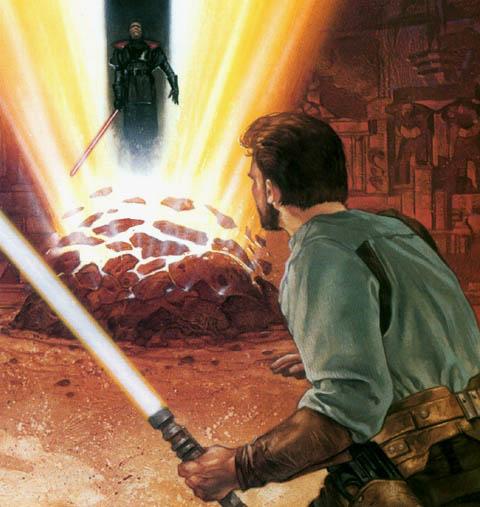
After the clash, the Bouncers met with Kyle Katarn. Aware of his mission, they were noncommittal, stating that "if not now, then someday" a Knight would fulfill their prophecy. Nevertheless, one of them, called Floater, agreed to guide him to the Valley of the Jedi. Floater touched each of his tribe members in farewell and led Katarn and his companions into the desert. Guiding them by night, Floater navigated the rebels through a series of canyons, until they were half a kilometer from the Valley. There, as dawn broke, an Imperial probe encountered Floater and the group. Grif Grawley lunged at the droid and activated its self-destruct, sacrificing himself. Despite the setback, Floater continued and led Katarn and Ors through underground aqueduct systems to the entrance of the Valley. There, Floater and Ors remained while Katarn continued alone into the Valley. When Imperials discovered the pair, Ors was captured, but Floater escaped through the aqueduct system. The Bouncer had done enough, however, as Katarn went on to free the spirits in the Valley and fulfill the Bouncer prophecy. Katarn soon left Ruusan, keeping its location a secret.
The location was later discovered by the Chistori Desann in 12 ABY. A former Jedi now working for the Empire Reborn, Desann used residual power in the Valley to create a Force imbued army. He was partially successful before Jedi Master Luke Skywalker expelled him and his forces from the planet. The Bouncers were seemingly unaffected by the encounter.
The Bouncers debuted in the Dark Forces novellas, where Morgan and Kyle Katarn visited Ruusan. They were then featured in the comic Star Wars: Jedi vs. Sith, which depicted events from the novellas set a thousand years earlier. Finally, these events were described in the novel Darth Bane: Path of Destruction, which expanded the backstory of Darth Bane.
The three sources contain some inconsistencies in the Bouncers' descriptions. In the novellas, the name Bouncer comes from their method of locomotion. They need to bounce to gain height and rely on the wind. However, in the comics, they can fly under their own power, and Path of Destruction describes them as "hovering" over the wounded. This has led some fans to believe Bouncers are telekinetic, but this is not the case. This article has followed the in-depth descriptions of the novellas, treating the comic depiction of floating as artistic license.
The novellas describe the Bouncers as having retractable tentacles, which they can control. In the comics, the Bouncers appear to have long hair that streams behind them, but they can still control it. Path of Destruction describes these as "ribbonlike tails." Another difference is that in the novellas, the Bouncers blink and open their eyes, whereas Path of Destruction describes their eyes as lidless. A final difference is that while the Bouncers are described as nocturnal in the novellas, they are frequently active during the day in the comics and novel. While none of these depictions are necessarily irreconcilable, they do exist in some tension with each other.
In Dark Forces: Rebel Agent, a Bouncer communicates with Morgan Katarn by writing on the sand in archaic Basic. In the audio dramatization, the Bouncer communicates with an ethereal voice.